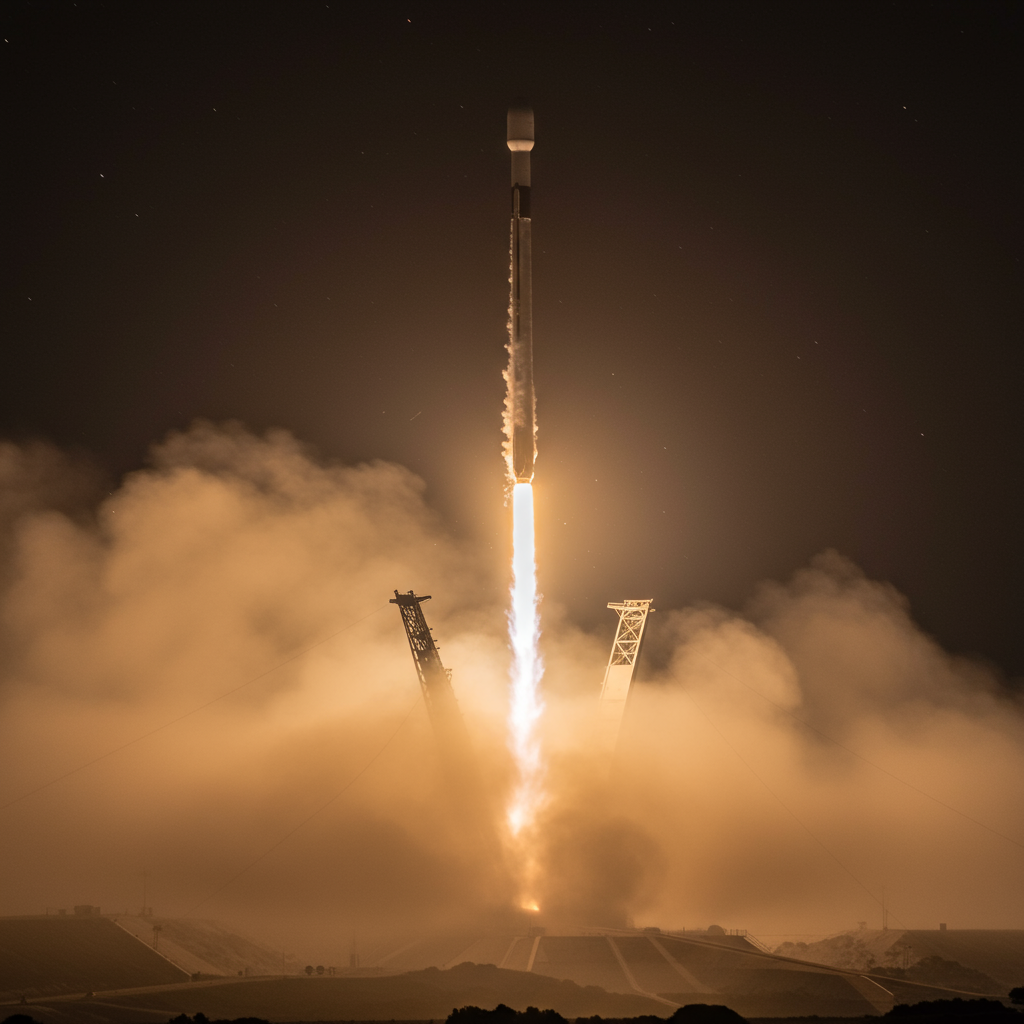SpaceX has once again demonstrated its unwavering commitment to global connectivity, successfully launching a Falcon 9 rocket from California’s Vandenberg Space Force Base. This pivotal mission, Starlink 17-4, marked the highly anticipated return of West Coast Falcon 9 launches after a two-week operational pause. Under a shroud of coastal fog, the towering rocket delivered 24 advanced Starlink V2 Mini satellites into a polar, low Earth orbit, significantly bolstering the rapidly expanding satellite internet constellation.
The launch, initially slated for an earlier date, showcased both the dynamic nature of spaceflight and SpaceX’s robust operational cadence. While originally targeted for August 9 local time, the mission experienced several postponements, eventually lifting off on Wednesday, August 13, 2025, at 10:05 p.m. PDT (1:05 a.m. EDT / 0505 UTC). Such delays, often influenced by weather or technical checks, are common in the complex world of rocket launches, underscoring the precision required for each mission.
Mastering Reusability: A Cornerstone of Space Operations
The Starlink 17-4 mission was a testament to SpaceX’s pioneering efforts in rocket reusability. The Falcon 9 first stage booster, tail number B1093, flawlessly executed its fifth flight, highlighting the remarkable engineering and operational efficiency that define modern space access. Approximately 8.5 minutes after its powerful ascent, B1093 achieved a precision landing on the autonomous droneship ‘Of Course I Still Love You’ stationed in the Pacific Ocean. This successful recovery marked the 144th landing on this particular vessel, adding to SpaceX’s already impressive record.
SpaceX’s commitment to reusability extends across its entire fleet. Earlier in 2025, the company achieved a historic milestone with its 400th Falcon 9 booster landing during the Transporter 13 rideshare mission from Vandenberg in March. This particular mission saw a Falcon 9 booster complete its 13th landing. Just weeks prior, in February 2025, another West Coast Starlink mission (Group 15-1) from Vandenberg also saw its booster, B1082, complete its 11th flight, demonstrating rapid turnaround times. These consistent recoveries are central to reducing launch costs and increasing flight frequency, making space more accessible than ever before.
Starlink’s Expanding Horizon: Connecting the Globe
Beyond the immediate launch, this mission contributes to the broader objective of Starlink’s global expansion. SpaceX continues to push the boundaries of internet accessibility, bringing high-speed, low-latency broadband to underserved regions worldwide. The company recently announced the availability of its Starlink service in Somalia and Israel, marking significant steps in its Middle Eastern and African outreach.
The Starlink coverage map reveals an ambitious roadmap for future expansion. Several countries and regions in the Middle East, including Gaza, the West Bank, and Iraq, are listed with “service date is unknown at this time,” indicating ongoing regulatory and infrastructure developments. Kuwait, for instance, anticipates Starlink coverage beginning sometime in 2025. Meanwhile, key nations like Saudi Arabia, Türkiye, and the United Arab Emirates are designated as “pending regulatory approval,” signifying the critical legal and governmental processes required for the service to launch.
The Strategic Importance of Starlink’s Middle East Push
SpaceX founder Elon Musk’s visit to Saudi Arabia in May 2025, alongside then-President Donald Trump and other U.S. officials, underscored the strategic implications of Starlink’s potential in the region. As part of the US-Saudi Investment Forum, the visit coincided with a landmark $142 billion military sales agreement, described by the White House as the “largest defense sales agreement in history.” This agreement included substantial investment in “air force advancement and space capabilities,” pointing to a broader integration of space technology into national infrastructure.
Notably, CNBC reported that during this trip, Musk finalized a deal with Saudi Arabia to enable Starlink usage for maritime and aviation applications. While the exact financial value of this specific agreement was not disclosed, it signals a significant commercial foothold for Starlink in a region poised for digital transformation. The potential for Starlink to provide reliable connectivity for ships and aircraft across vast stretches of land and sea offers immense value, not just commercially, but also for security and logistics.
Vandenberg: A Vital Hub for Polar Orbit Missions
The Vandenberg Space Force Base in California remains a crucial launch site for SpaceX, particularly for missions requiring a polar orbit. Its strategic location on the West Coast allows for launches southward over the Pacific Ocean, directly into orbits that circle the Earth’s poles. This trajectory is ideal for Earth observation satellites, weather monitoring, and a significant portion of the Starlink constellation, which aims to provide global coverage.
Looking ahead, August 2025 is shaping up to be a bustling month for SpaceX operations from Vandenberg. Beyond the Starlink 17-4 mission, the base was anticipating further Starlink deployments (17-5 on August 13 and 17-6 on August 17) and a crucial Bandwagon 4 rideshare mission on August 24. Rideshare flights, like the successful Transporter 13 mission in March 2025 which deployed 74 diverse satellites, allow multiple smaller payloads from various customers to share a single rocket launch. This cost-effective approach significantly lowers barriers to space access for commercial and government entities, fostering innovation across the satellite industry. The frequency of these launches means spaceflight enthusiasts across California, and even Arizona, often have opportunities to witness these spectacular liftoffs.
The Enduring Legacy of the Falcon 9
The Falcon 9 continues to be the backbone of SpaceX’s operations, proving itself as one of the most reliable and frequently flown orbital rockets in history. Its robust design, coupled with SpaceX’s pioneering reusability program, has revolutionized space access. From deploying massive constellations like Starlink to launching crewed missions and delivering critical payloads for diverse customers, the Falcon 9 consistently delivers. The ongoing success of missions from Vandenberg underscores SpaceX’s comprehensive capability to launch from multiple sites, supporting a relentless pace of operations across different orbital requirements. The strategic importance of reusable launch vehicles cannot be overstated, as they drive down costs, increase launch cadence, and open new frontiers for exploration and commercial exploitation of space.
Frequently Asked Questions
What is the Starlink V2 Mini satellite mission about?
The Starlink V2 Mini satellite mission is a key component of SpaceX’s global broadband internet constellation. Each mission, like Starlink 17-4, deploys a batch of these advanced satellites into a low Earth polar orbit. The “V2 Mini” designation indicates an optimized, next-generation design that offers improved capacity and performance compared to earlier Starlink versions, aiming to provide high-speed, low-latency internet access to users worldwide, particularly in remote and underserved areas.
Where does SpaceX primarily launch its West Coast missions from?
SpaceX primarily conducts its West Coast missions from Space Launch Complex 4 East (SLC-4E) at Vandenberg Space Force Base in California. This site is strategically vital for launching payloads into polar orbits, which are crucial for Earth observation, weather, and a significant portion of the Starlink constellation. Vandenberg’s location allows rockets to fly south over the Pacific Ocean, avoiding populated landmasses during their ascent.
How does SpaceX’s booster reusability impact space launch costs?
SpaceX’s booster reusability, exemplified by the Falcon 9’s ability to land and be refurbished for multiple flights, dramatically reduces the cost of space launches. By eliminating the need to build a new first stage for every mission, SpaceX saves significant material and manufacturing expenses. This innovation has democratized access to space, making satellite deployment more affordable for commercial and government entities, accelerating the growth of the space economy, and supporting ambitious projects like the vast Starlink constellation.




